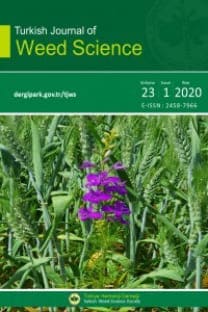Mısırda Çıkış Öncesi Kullanılan Bazı Herbisitlerin Mısır Bitkisinin Çimlenmesi ve Gelişimi Üzerine Etkileri
The Effects of Some Pre-emergence Herbicides Used on Germination and Development of Corn Plant
Corn, Pre-emergence application, Pendimethalin Dimethenamid-P, Isoxaflutole+Thiencarbazone-methyl+Cyprosulfamide,
___
- Aksoy A., Uygur FN. (2009). Buğday ekim alanlarinda kullanılan bazı herbisitlerin buğday sonrası ekilen kültür bitkilerine yan etkilerinin araştırılması. Çukurova Üniversitesi, Fen Bilimleri Enstitüsü, Doktora Tezi, 152 s., Adana. Ampong-Nyarko K. (1994). Weed management in tropical cereals. Maize, sorghum and millet. Weed Management for Developing Countries FAO, Rome-Italy, P. 264-270. Anonim. (2017). Corn production according to countries. Food and Agriculture Organization of the United Nations. http://www.fao.org/faostat/en/?#country/223. (Erişim tarihi: 3 Mayıs 2017). Anonim. (2018). Türkiye’de mısır üretim miktarı. Türkiye İstatistik Kurumu. https://biruni.tuik.gov.tr/medas/?kn=92&locale=tr. (Erişim tarihi: 20 Mart 2019). Baghestani MA., Zand E., Rahimian-Mashhadi H., Soufizadeh S. (2005). Morphological and physiological characteristics which enhance competitiveness of winter wheat (Triticum aestivum L.) against Goldbachia laevigata. Iranian J Weed Sci 1: 111-126. Berzsenyi P., Bonis B., Arendas T. (1995). Investigations about the effects of some factors influencing the efficacy of postemergence weed control in maize (Zea mays L.), Dang Quoc Lap, Agricultural Research Institute of the Hungarian Academy of Sciences, 9th EWRS Syposium Budapest, 257-264. Boz Ö., Unay A., Doğan MN., Şimşek S., Arat BB., Keşşaf D. (2015). Tavsiye dışı uygulanan herbisitlerin kültür bitkisi üzerinde oluşturduğu simptomlar. Adnan Menderes üniversitesi Ziraat Fakültesi araştırma (Tez hariç) kitabı, 41-66. Doğan MN., Ünay A., Boz Ö., Albay F. (2004). Determination of optimum weed kontrol timing in maize (Zea mays L.). Turkish Journal of Agriculture and Forestry, 28, 349-354. Isık D., Dok M., Altop EK., Mennan H. (2015). Mısır yetiştiriciliğinde erken toprak işleme ve glyphosate’nin çıkış öncesi ve çıkış sonrası yabancı ot mücadele yöntemleri ile birlikte kullanılabilirliğinin araştırılması. Tarım Bilimleri Dergisi, 21, 596- 605. Greenland RG. (2003). Injury to vegetable crops from herbicides applied in previous years. Weed Technology, 17(1), 73-78. Griffin JL. (2005). Herbicide/Soil Interactions. http://www.lsuagcenter.com/M CMS/ RelatedFiles/% 7BC5E3E644-A39F-4A5F-9B39-066D5C915E12% 7D/Griffin. WeedCourse. Chapter4.2005.pdf (Son erişim tarihi:06.01.2009). Güngör M. Uygur FN. (2005). Adana ili mısır ekim alanlarında yabancı otlara karşı uygulanan kimyasal mücadelenin önemi ve ortaya çıkan sorunların araştırılması, Çukurova Üniversitesi, Fen Bilimleri Enstitüsü, Yüksek lisans Tezi, 171s. Adana. Hall RM., Swanton CJ., Anderson WG.(2002). The critical period of weed kontrol in grain maize (Zea mays). Weed Science Congress, 40: 441-447. Kiely T., Donaldson D., Grube A. (2004). Pesticides industry sales and usage: 200 and 2001 Market estimates. U.S. Environmental Protection Agency, Washington DC 200460 /U.S.A. Kotoula-Syka E., Eleftherohorinos IG., Gagianas AA., Sficas AG. (1993). Phytotoxicity and persistence of chlorsulfuron, metsulfuron‐methyl, triasulfuron and tribenuron‐methyl in three soils, Weed Research, 33(5), 355-367. Leonard G., Sankula S., Reigner N. (2003). Maize-Herbicide-tolerant case study, potential impact for improving, pest management in European agriculture, The National Center for Food and Agricultural Policy. Mutlu G., Üstüner T. (2017). Tepraloxydim, fluazifop-p-butyl ve metribuzin herbisitlerinin toprak kökenli bazı fungal patojenlerin koloni gelişmine ve sporulasyonuna etkisi. Bitki Koruma Bülteni 57(1), 21-38. Oerke EC., Dehne HW.(2004). Safeguarding protection-losses in major crops and the role of crop protection. Crop Protection, 23, 275-285. Oerke EC., Steiner U. (2006). Abschatzung der ertragsverluste ın maisandau. In: Ertragsverluste und pflanzenschutz die anbausituation fur die wirtschafth wichtigsten kulturpflanzen-germphytomedical society series, Band 6, 63-79. O’Sullivan J., Zandstra J., Sıkkema P. (2002). Sweet corn (Zea mays) cultivar sensitivity to mesotrione, Weed Technology, 16(2),421-425. Özer Z. (2003). Niçin yabancı ot bilimi (Herboloji). Türkiye 1. Herboloji Kongresi, s. 1-7, 3-5 Şubat 2003. Adana. Özer Z., Kadıoğlu İ., Önen H., Tursun N. (2008). Herboloji (Yabacı ot bilimi), genişletilmiş II. baskı, Gaziosmanpaşa Üniversitesi Ziraat Fakültesi Yayınları No: 20, 228-230, Tokat. Smith MC., Shaw DR., Miller DK. (2005). In field bioassay to investigate the persistence of imazaquin and pyrithiobac. Weed Science, 53(1), 121-129. Tepe I. (2007). Türkiye’de tarım ve tarım dışı alanlarda sorun olan yabancı otlar ve mücadelesi, Yüzüncü Yıl Üniversitesi, Ziraat Fakültesi, Bitki Koruma Bölümü Ders Kitabı, No: 18, Van, 237 s. Thonke KE. (1991). Political and practical approach in Scandinavia towards reducing herbicide inputs, Brighton Crop Protection Conference, Brighton, 1183-1190. Torun H., Uygur S. (2012). Herbisit uygulamalarının bazı kültür bitkileri üzerinde oluşturduğu zararlanmalar. Türkiye Herboloji Dergisi, 15(1-2), 1-12. Uysal B., Kadıoğlu İ. (2012). Farklı dozlarda kullanılan bazı herbisitlerin mısırda yabancı otlanmaya etkisi. Gaziosmanpaşa Üniversitesi, Fen Bilimleri Enstitüsü, Yüksek Lisans Tezi. 59s.,Tokat. Üremiş İ. (2003). Adana’da mısır ekilişlerinde uçakla herbisit uygulamaları üzerinde bir araştırma, Çukurova Üniversitesi, Fen Bilimleri Enstitüsü, Bitki Koruma Anabilim Dalı Yüksek Lisans Tezi, 95 s., Adana. Vasilakoglou IB., Eleftherohorinos IG. (2003). Persistence, efficacy, and selectivity of amide herbicides in corn. Weed Technology, 17(2), 381-388. Yavuz R., Esmeray M., Urin,V. (2017). Bazı herbisitlerin mısır ve yabancı ot biyomasına etkisi, Bahri dağdaş Bitkisel araştırma dergisi,6 (2), 1-6. Zoschke A. (1994). Toward reduced herbicide rates and adapted weed management. Weed Technol. 8, 376-386.
- ISSN: 1303-6491
- Başlangıç: 1998
- Yayıncı: Türkiye Herboloji Derneği
Ordu ve Giresun İllerindeki Sicyos Türlerinin Moleküler Karakterizasyonu
Berna Nur YEŞİLTAŞ, Onur KOLÖREN
Myagrum perfoliatum L. (Gönül Hardalı) Tohumlarında Dormansi Kırma Üzerine Araştırmalar
Olcay BOZDOĞAN, Furkan UYAR, Yücel KARAMAN, Çiğdem DEMİRTAŞ, Kemal UÇAR, Nihat TURSUN
Tokat İlinde Görülen Bazı Bitkilerin Boya Bitkisi Olarak Kullanım Olanakları
İzzet KADIOĞLU, Bahadır ŞİN, Burcu KINALI
Yıldız NEMLİ, Ahmet KAYNAR, Akın KAYADAN
Esra YILMAZ, İzzet KADIOĞLU, Yasin Emre KİTİŞ
Jiban SHRESTHA, Krishna Prasad TİMSİNA, Subash SUBEDİ, Dipesh POKHREL, Amit CHAUDHARY
Düzce İlindeki Arsız Zaylan (Ambrosia artemisiifolia L.) Populasyonlarının Durumu
Kültür Bitkileri ile Ekim Nöbeti Uygulamalarının Yabancı Ot Yönetimine Etkisi
